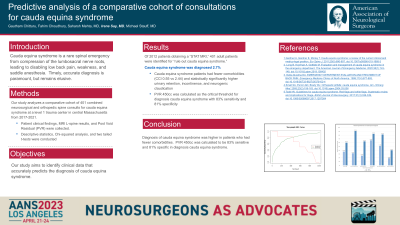Predictive analysis of a comparative cohort of consultations for cauda equina syndrome
Predictive Analysis of a Comparative Cohort of Consultations for Cauda Equina Syndrome
Friday, April 21, 2023


Irene Say, MD
Assistant Professor
University of California, San Francisco
San Francisco, California, United States
ePoster Presenter(s)
Introduction: Cauda equina syndrome is a rare, but catastrophic neurosurgical emergency secondary to severe lumbar stenosis. Classically, patients develop any combination of back and lower extremity pain, weakness, saddle anesthesia, and bowel/bladder incontinence. Making a timely, accurate diagnosis is paramount to prevent permanent disability. Previous research has not found a consensus in diagnostic criteria and is limited by small sample size or cursory statistical analysis. Here, we present the largest, combined neurosurgical and orthopedic spine surgery cohort of consultations for cauda equina syndrome to date and perform predictive statistical modeling of clinical factors leading to operative intervention.
Methods: All patients who presented to our tertiary, academic medical center for a spine consultation for possible cauda equina syndrome from 2018-2022 were retrospectively reviewed. Presenting symptoms, history/physical exam findings, post-void residuals and MRI lumbar spine results were analyzed. Descriptive statistics, Chi-squared analysis, and two-tailed t-tests were conducted on corresponding demographics, comorbidities, and clinical data.
Results: 401 consecutive patients were identified and cauda equina syndrome was diagnosed in 11 patients (2.7%). Patients diagnosed with cauda equina syndrome (CES+) and patients not diagnosed with cauda equina syndrome (CES-) had Charlson comorbidities of 0.55 and 2.44, respectively (p < 0.05). CES+/CES- patients showed significant differences in urinary incontinence (90.9%/32.1%, p< 0.001), urinary retention (63.6%/25.6%, p< 0.01), leg symptoms (81.8%/51.4%, p< 0.05), and average PVR values in mL (570.0/223.82, p< 0.01). PVR values > 350mL had a sensitivity of 85.7% and a specificity of 78.6% in diagnosing CES.
Conclusion : Our results found that the combination of PVR and the history/physical exam findings were the most predictive in diagnosing cauda equina syndrome. PVR >350mL alone demonstrated the highest predictive value, especially after stratification for non-neurogenic urinary symptoms. Future studies include analyzing negative predictive factors, expanding to multiple sites, and implementing a clinical scoring system for our emergency room and primary care providers.
Methods: All patients who presented to our tertiary, academic medical center for a spine consultation for possible cauda equina syndrome from 2018-2022 were retrospectively reviewed. Presenting symptoms, history/physical exam findings, post-void residuals and MRI lumbar spine results were analyzed. Descriptive statistics, Chi-squared analysis, and two-tailed t-tests were conducted on corresponding demographics, comorbidities, and clinical data.
Results: 401 consecutive patients were identified and cauda equina syndrome was diagnosed in 11 patients (2.7%). Patients diagnosed with cauda equina syndrome (CES+) and patients not diagnosed with cauda equina syndrome (CES-) had Charlson comorbidities of 0.55 and 2.44, respectively (p < 0.05). CES+/CES- patients showed significant differences in urinary incontinence (90.9%/32.1%, p< 0.001), urinary retention (63.6%/25.6%, p< 0.01), leg symptoms (81.8%/51.4%, p< 0.05), and average PVR values in mL (570.0/223.82, p< 0.01). PVR values > 350mL had a sensitivity of 85.7% and a specificity of 78.6% in diagnosing CES.
Conclusion : Our results found that the combination of PVR and the history/physical exam findings were the most predictive in diagnosing cauda equina syndrome. PVR >350mL alone demonstrated the highest predictive value, especially after stratification for non-neurogenic urinary symptoms. Future studies include analyzing negative predictive factors, expanding to multiple sites, and implementing a clinical scoring system for our emergency room and primary care providers.
